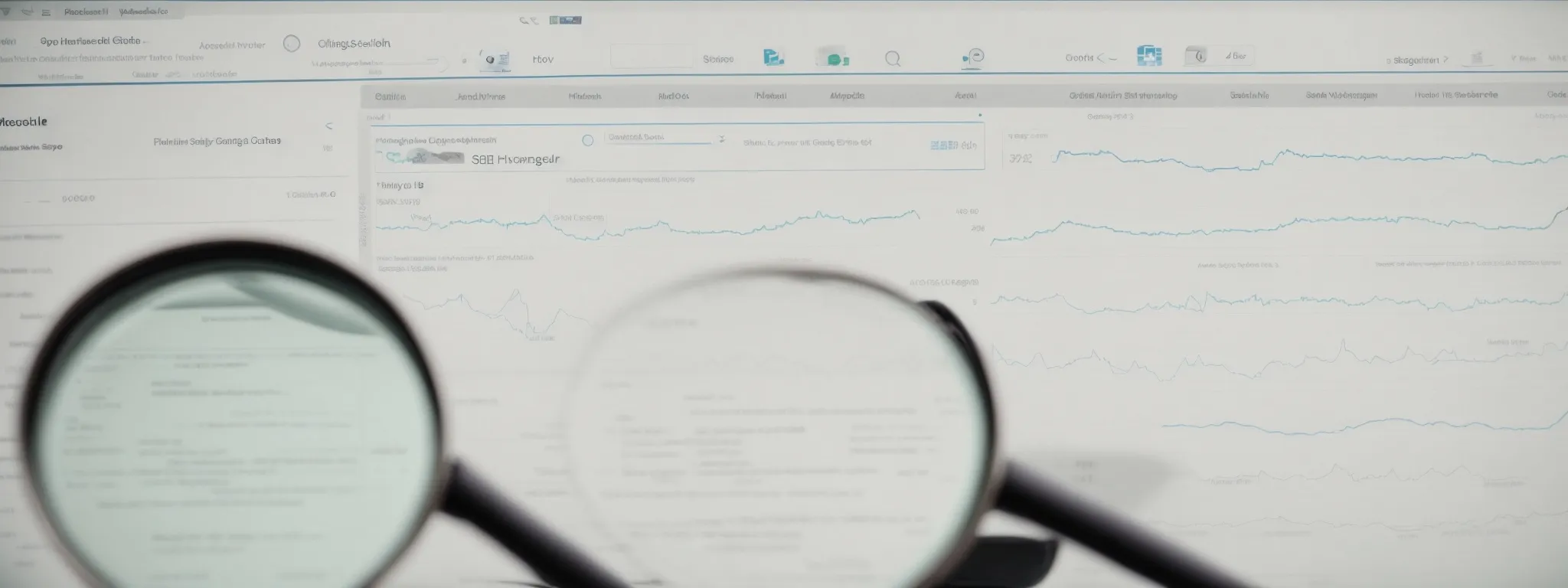Decoding Ranking Factors: A Comprehensive Guide
Mastering Search Engine Algorithms: Decoding Ranking Factors With a Comprehensive Guide Navigating the labyrinth of search engine algorithms is a task that demands precision, insight, and an […]
Mastering Search Engine Algorithms: Decoding Ranking Factors With a Comprehensive Guide
Navigating the labyrinth of search engine algorithms is a task that demands precision, insight, and an evolving understanding of SEO ranking factors.
From the weight assigned to quality content and user experience to the subtleties of title tags and backlinks, businesses and marketers alike must crack the code of what propels web pages to the pinnacle of Google search results.
The complexities of Google’s algorithm, influenced by entities such as Andrey Lipattsev’s query satisfaction and RankBrain’s machine learning, challenge brands to continuously adapt their strategies for online visibility.
Technical SEO, on-page optimization, and crafting an effective SEO content strategy have become essential components in achieving a top Google ranking.
Keep reading to unlock the secrets of search engine success and how LinkGraph’s SEO services can enhance your brand’s digital footprint.
Key Takeaways
- Understanding Search Algorithm Updates Is Essential for Maintaining Website Visibility
- On-Page Elements Like Keyword Optimization and HTML Tag Structuring Significantly Influence Search Rankings
- Quality Backlinks and Domain Authority Are Crucial for Off-Page SEO Success
- Technical SEO Aspects Like Site Speed and Mobile Responsiveness Directly Impact Search Engine Rankings
- Continuous Adaptation to Search Algorithm Changes Ensures Sustained Relevance and Search Rankings
Unveiling the Core Elements of Search Algorithms

In the complex terrain of digital marketing, grasping the intricacies of search algorithm functionality stands as a cornerstone for any business aiming to secure a robust online presence.
With search engines perpetually refining their mechanisms to prioritize content and websites, understanding these foundational principles becomes pivotal.
Each algorithm update heralds potential shifts in search results, compelling brands to adapt swiftly for sustained visibility.
With a detailed exploration of these factors, grasping the nuances of how entities like Google interpret and rank digital content can empower marketers to align their SEO strategies more effectively with the search landscape’s evolving contours.
Understanding the Basics of Search Algorithm Functionality
The quest for a top Google ranking is an intricate game of chess against the elusive search algorithms. At the core of this challenge is the understanding that algorithms like Google’s RankBrain and the latest updates operate under complex rules, primarily designed to enhance user experience by presenting the most relevant and quality content.
To penetrate the veils of search engine optimization, one must appreciate that factors such as domain authority, relevant backlinks, and the use of strategic keywords profoundly impact a site’s visibility in search results. Mastery in these areas can effectively propel a brand’s digital footprint into the spotlight.
How Search Engines Prioritize Content and Websites
Search engines employ a meticulously crafted set of criteria to determine the standing of websites in search results, prioritizing those that demonstrate high levels of authority, trustworthiness, and user relevance. The algorithms are engineered to acknowledge the value of a web page based on numerous seo ranking factors, including user engagement, page experience, and the presence of authoritative backlinks, which collectively help a website to ascend to the enviable position of a top Google ranking.
Given the dynamic nature of search algorithm advancement, websites must maintain a pulse on algorithm updates to ensure their content meets the evolving standards of search engines. SearchAtlas SEO software, for instance, equips users with nuanced insights, enabling them to refine SEO content strategies and enhance on-page services in alignment with the pressing demands of contemporary search engine precedents for optimal positioning in the search index.
The Impact of Algorithm Updates on Search Results
Amid the digital realm, LinkGraph’s SEO services shine by providing insights into how algorithm updates shift the terrain of SEO ranking. The reality is, with each Google algorithm alteration, from the PageRank system to the complexities of RankBrain, the fidelity of search results is recalibrated, mandating businesses to adjust their online strategies to maintain or improve their visibility within SERPs.
LinkGraph adeptly navigates these changes, leveraging the SearchAtlas SEO software’s prowess to parse through the subtleties of updates and the resulting SERP volatility. Clients can depend on this guidance to adapt their SEO content strategies, ensuring that their web pages are fortified against the tides of change and remain steadfast in delivering the user experience and content quality that search engines reward.
Dissecting on-Page Ranking Factors for SEO Mastery

Embarking on the journey of deciphering on-page ranking factors is akin to unlocking the secrets of a map to hidden treasure for modern enterprises seeking to excel in search engine optimization.
Within the labyrinth of on-page elements, certain critical components stand apart as essential for enhancing a web page’s relevance and authority—a beacon for search engines as they sort through the boundless ocean of online content.
Mastery in keyword optimization, combined with expertly structured HTML tags and meticulously crafted meta descriptions and title tags, form the backbone of an SEO scaffold, significantly boosting a site’s visibility and user appeal.
By diving deep into these aspects, businesses can construct a formidable content strategy that aligns with search algorithms’ quest to present the most pertinent and engaging results to users.
Importance of Keyword Optimization for Relevance
Keyword optimization serves as a critical fulcrum in the lever of search engine optimization, deftly balancing the density and placement of terms that users are likely to input during their search queries. When LinkGraph’s SEO services refine a client’s keyword strategy, they not only target high-intent phrases but also ensure those terms mirror the searcher’s language, bolstering the relevance of content in the eyes of both search engines and potential visitors.
At its essence, the art of keyword optimization extends beyond mere inclusion of targeted terms; it encompasses the strategic embedding of these keywords to resonate with the entity search behavior that underpins Google’s search results. A well-executed keyword strategy by LinkGraph’s SEO teams is capable of transforming a web page into a magnet for relevant traffic, entwining searcher intent with quality content to enhance the page’s authority and propel it upwards in local search results.
Structuring Content With SEO-Friendly HTML Tags
Engaging with quality content is only part of the narrative when conquering the digital landscape; equally vital is structuring that content with SEO-friendly HTML tags. These semantic markers aid search engines in comprehending the significance of web page content and prioritizing it accordingly: title tags present a succinct outline of the page’s topical focus, description tags offer a snapshot of the content to lure searchers in search results, and header tags organize the content hierarchy for a seamless user journey.
Indeed, strategic implementation of HTML tags is a subtle yet powerful instrument in the toolset of LinkGraph’s SEO services, facilitating the clear and effective communication of a web page’s purpose and relevancy to both users and search algorithms. Through meticulous crafting and placement of HTML tags, a brand’s digital content aligns more closely with the factors vital for achieving high search engine visibility:
- Enhancing the clarity and focus of title tags to reflect core keywords and themes
- Optimizing description tags with compelling language that mirrors searcher intent
- Employing header tags to order content logically and improve navigability for users
Maximizing the Role of Meta Descriptions and Titles
In the realm of on-page SEO, meta descriptions and titles hold considerable weight as gateways to higher search rankings. A meta description should encapsulate the essence of the content, compelling users to click through from search results, while the title must be equally persuasive and keyword-rich to promise relevance and value.
Titles serve as the bold announcement on the SERP stage, imparting a first impression that can make or break user engagement: a clear, accurate, and keyword-optimized title not only informs the searcher but also contributes to a website’s authority signal for Google search algorithms. Following this strategic tune leads to an orchestrated rise in domain factors pertinent to enhancing search visibility.
- Create meta descriptions that marry relevance with allure, tempting users to explore further.
- Fashion titles as concise yet all-encompassing headlines that encapsulate the content’s theme.
- Utilize keyword optimization to elevate both titles and descriptions, syncing them with user search intent.
The Significance of Off-Page SEO in Algorithm Ranking

In the pursuit of a commanding online presence, the realm of search engine optimization stretches far beyond the confines of a website’s own borders.
Off-page SEO exists as an undeniable force, where external factors play a pivotal role in dictating the success of a brand’s search rankings.
From the influence of high-quality backlinks to the subtle yet significant weight of social signals and the revered authority of a domain, these external elements collectively forge a significant part of the formula that search algorithms use to assess and rank web pages.
As marketers look to refine their off-page strategies, it is essential to understand how these seemingly distinct pieces converge to form a unified ranking narrative.
Deciphering the Value of Quality Backlinks
In the world of search engine optimization, quality backlinks stand as a testament to a website’s credibility and importance. LinkGraph’s SEO services meticulously cultivate these connections, understanding that each quality backlink serves as an endorsement in the eyes of search engines, enhancing a website’s authority and consequently, its placement in search results.
LinkGraph’s granular approach to white label link building focuses not just on quantity, but on securing links from reputable sources that align with a client’s domain. Their expertise reveals that a strategic backlink profile has a substantially positive impact on search rankings, guiding users towards a client’s site as a trusted resource amidst a sea of competitors.
The Role of Social Signals in Off-Page SEO
In the tapestry of search engine optimization, social signals serve as subtle yet pivotal indicators of a page’s popularity and user engagement. These signals, reflecting the user activity tied to a page through likes, shares, and comments across various social media platforms, act as nuanced cues to search engines.
Acknowledging the role of social signals, LinkGraph’s SEO services consider them as informal endorsements, suggesting a ripple of user-driven approval that can contribute to the external validation of a website’s content. While not direct ranking factors, their influence indirectly permeates the SEO domain, supporting a site’s pursuit of improved visibility and authority.
| SEO Factor | Impact on Ranking | Supported by LinkGraph’s Services |
|---|---|---|
| Social Signals | Indirect Indicator of Popularity | Enhanced Through User Engagement Strategies |
Understanding the Influence of Domain Authority
Domain authority is a critical metric that gauges a website’s potential to rank highly in search engine results, functioning as an estimator of credibility and expertise. LinkGraph’s SEO services underscore the importance of this measure, recognizing that a higher domain authority correlates with an increased likelihood of achieving search engine prominence and visibility to the target audience.
Developed with a nuanced approach, the proprietary algorithms behind LinkGraph’s SearchAtlas SEO software evaluate numerous elements such as the quality, relevance, and number of backlinks to calculate a domain’s authority. Outshining simple metrics, this advanced assessment offers clients a clear perspective on their website’s standing in the digital ecosystem, guiding the optimization of their off-page SEO endeavors to bolster their stature within the competitive arena of search rankings.
Technical SEO and Its Place in Search Algorithms

In an era where digital intricacies govern the visibility of brands and products, technical SEO emerges as a non-negotiable pillar integral to mastering search engine algorithms.
As search engines evolve, their criteria for ranking websites no longer hinge solely on content alone but extend into the technical arena where site speed, mobile responsiveness, and crawlability lay the groundwork for online success.
Technical SEO encompasses these critical elements, each acting as a cog in the optimization machine that drives search engine rankings.
Ensuring swift load times, seamless mobile experiences, and unimpeded access for search engine crawlers are paramount in signaling to Google the readiness and relevancy of a web page for user queries.
This introduction sets the stage for an in-depth examination of these factors, highlighting their collective role in shaping the search algorithms that determine a website’s potential to capture top search positions.
Site Speed and Its Effect on Search Engine Rankings
Site speed is a critical factor in search engine rankings, determining how swiftly a web page loads for a visitor. As part of Google’s emphasis on user experience, pages that load quickly are often rewarded with higher positions in search results, providing users with the immediate information they seek.
Recognizing this, LinkGraph’s technical SEO services focus on enhancing site speed to optimize web performance in the eyes of users and search engines alike. Accelerated page speeds facilitate better engagement, reducing bounce rates and sending positive signals to search engines that a site is worthy of a leading position:
- Optimizing image sizes and compression for quicker loading
- Minimizing server response time by using efficient web hosting solutions
- Implementing browser caching to save data from previously visited pages
Why Mobile Responsiveness Is Crucial for SEO
In the realm of search engine optimization, mobile responsiveness is not just a modern convenience—it is a fundamental element that search engines like Google deem critical for user experience. With the burgeoning prevalence of mobile devices, a mobile-friendly website now serves as a key determinant in securing a prominent rank within search results.
This pivot towards mobile optimization reflects the user-centric approach of SEO, where the ease of navigation and readability on smaller screens enhances user engagement and retention: a website that seamlessly adapts to various devices is slated for favorable evaluation by the algorithms that underline search rankings.
- Adapting web design to accommodate different screen sizes and orientations
- Ensuring touch-friendly navigation and interactive elements
- Optimizing site speed for mobile devices to reduce loading times
Ensuring Crawlability and Indexability for Web Pages
Crawlability and indexability are the bedrock upon which search engines build their understanding of web pages. LinkGraph’s meticulous approach ensures that web pages are accessible for search engine crawlers, thus facilitating their appearance in search results: a cornerstone service to fortify the online presence of any brand.
| Technical Aspect | Impact on SEO | Enhanced by LinkGraph |
|---|---|---|
| Crawlability | Essential for Discoverability | Optimization of Site Structure |
| Indexability | Crucial for Visibility in SERPs | Verification of Content Accessibility |
In the context of indexability, LinkGraph ensures that after the crawler’s visit, the content is distinct and primed for inclusion in Google’s search index. By addressing sitemaps, robot.txt files, and employing schema markup, LinkGraph’s SEO services amplify a website’s potential to not just be found but also to rank effectively in search engine results.
The Growing Importance of User Experience in SEO

In an era where the user’s digital journey defines online success, search engines are increasingly prioritizing the nuances of user experience (UX) in their ranking algorithms.
This paradigm shift places users at the heart of SEO practices, as their interactions on a website offer invaluable metrics for the evaluation of content relevancy and site structure.
In the pursuit of high SEO rankings, the burden rests on marketers to craft web experiences that speak directly to the user’s quest for intuitive navigation and engagement with high-quality content.
LinkGraph’s SEO services are specifically tailored to enhance these elements, recognizing the pivotal role of user-centered design and compelling content in forging a path to top-tier search engine placements.
How User Behavior Metrics Influence SEO Rankings
Within the domain of SEO, user behavior metrics serve as critical indicators of a website’s performance, playing a significant role in influencing search rankings. Metrics such as click-through rate (CTR), time on site, and bounce rate provide search engines with insights into the relevance and user appeal of a web page: if users find what they are looking for and remain engaged, it signifies to search engines that the content is valuable.
This correlation is etched into the algorithms that determine search rankings, as search engines strive to deliver the content that best satisfies the user’s intent. Enhanced user engagement represents a tacit endorsement of content quality, signaling that a website merits a higher placement in the search results:
- User interactions illustrate content relevancy, influencing search algorithms favorably.
- Prolonged user engagement on a website is interpreted as content quality, prompting uplifted search rankings.
The Necessity of Intuitive Navigation and Structure
The harmony of a website’s navigation and structure is not incidental but a strategic venture crucial to fostering user engagement and satisfaction. Intuitive navigation ensures users can find the desired information with ease, effectively supporting the goal of a positive user experience, a facet especially regarded by Google’s evolving search algorithms.
The clarity of a website’s structure invariably influences its usability, rendering it straightforward for both users and search engine crawlers to traverse. This element of website design enhances a brand’s digital presence and authority, significantly impacting its search rankings.
- Implementing clear and concise menus for effortless user navigation
- Strategizing content layout for logical flow and easy access
- Integrating a search function to further smooth out the user’s path within the site
Content Quality and Its Direct Impact on User Engagement
The caliber of content on any given webpage is a forceful magnet for user engagement, with implications that reverberate throughout a brand’s search rankings. When LinkGraph’s SEO services orchestrate a content symphony harmonized to the user’s expectations, they not only meet but exceed the standards of quality, fostering profound engagement that captivates and retains the audience.
Equally, the potency of well-crafted content extends to its sway over user behavior—a principal factor in search engine algorithms. By upholding the highest levels of content quality, which encompasses both the informational richness and the compelling nature of the prose, LinkGraph ensures that every web page is a nexus of user engagement, solidifying its influence on search engine rankings.
Keeping Up With Changing Algorithmic Signals

As the digital landscape morphs with relentless pace, the capacity to stay attuned to the ever-evolving search engine algorithms emerges as a critical facet of online success.
Websites and marketers must continually employ adaptive strategies to navigate the fluid nature of ranking factors, anticipating the integration of artificial intelligence and machine learning as key influencers in shaping the future of search.
This quest mandates the construction of a resilient SEO framework capable of withstanding the ebb and flow of algorithmic shifts, ensuring that a brand’s search engine presence remains steadfast and dynamic.
In this pivotal epoch, a comprehensive guide serves as an essential tool for those determined to master the subtleties of search engine algorithms and secure a vanguard position in the online arena.
Strategies for Adapting to Continuous Algorithm Evolutions
To adeptly navigate the ongoing evolution of search algorithms, it is essential for entities to align themselves with the forward-thinking approach of LinkGraph’s SEO services. By embracing analytical agility, clients are equipped to swiftly decode shifts in search algorithm trends, enabling them to refine their SEO strategies proactively, ensuring sustained relevance and top-tier search rankings.
LinkGraph excels in employing a data-driven methodology to adapt to algorithmic changes, relying on the precision and comprehensive analytics of SearchAtlas SEO software. This robust tool assesses and anticipates the nuances of algorithmic developments, allowing for an optimization process that is both responsive and informed, and positions a brand’s digital footprint ahead of competitive curves.
Forecasting the Future of Search With AI and Machine Learning
The integration of artificial intelligence (AI) and machine learning technologies into search engine algorithms is poised to revolutionize the digital landscape. These advancements forge new frontiers in understanding user behavior, predicting search trends, and fine-tuning the efficacy of search results based on an accumulation of nuanced data.
LinkGraph’s SEO services are strategically oriented to embrace these technological progressions, recognizing that the implementation of AI and machine learning will undoubtedly refine the precision of search engine rankings. This proactive approach ensures that clients’ SEO strategies are aligned with the forthcoming paradigm, aiming to secure a potent and future-proof online presence.
Building a Resilient SEO Approach Amidst Ranking Shifts
In an environment where the constants are unpredictability and change, constructing a nimble SEO strategy is crucial. LinkGraph’s SEO services are designed to withstand the fluctuations of search algorithms, offering robust adaptability to maintain strong search rankings.
LinkGraph’s approach to SEO resiliency involves staying vigilant to algorithmic variations and implementing tailored adaptations. This preparedness allows their clients’ digital presence to not only endure but thrive, despite the relentless evolution of search engine parameters.
Conclusion
Mastering search engine algorithms is crucial for any business looking to dominate the online space.
By understanding the multitude of factors that influence search rankings, from on-page elements like keyword optimization and HTML tags to off-page considerations such as backlinks and social signals, brands can craft strategies that speak to search engines’ evolving criteria.
Technical SEO elements, including site speed and mobile responsiveness, along with a focus on user experience through intuitive navigation and quality content, play a major role in enhancing search engine visibility.
As Google’s algorithms continue to integrate AI and machine learning, staying ahead requires vigilance and adaptability.
Services like LinkGraph offer valuable expertise, helping businesses navigate algorithm evolutions and maintain robust SEO strategies.
In essence, a comprehensive guide on search algorithms becomes an invaluable tool, allowing brands to decode ranking factors effectively and secure a competitive edge in the digital marketplace.















































































